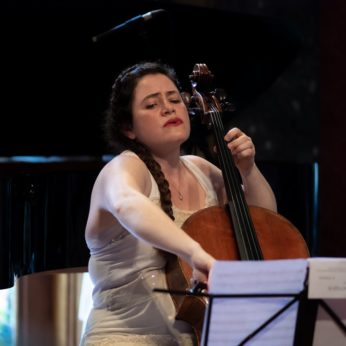Composer: Johann Sebastian Bach (b. 1685 - d. 1750)
Performance date: 04/07/2019
Venue: St. Brendan’s Church
Duration: 00:26:06
Recording Engineer: Gar Duffy, RTÉ
Instrumentation: vc
Instrumentation Category:Solo
Artists:
Emmanuelle Bertrand -
[cello]

Suite No 6 in D major, BWV 1012
1.Prélude
2. Allemande
3. Courante
4. Sarabande
5. Gavotte I & II
6. Gigue
The opening of the Sixth Suite is like a blaze of light, gloria in excelsis Deo sung with all five voices in sublime celebration. The Suite was originally written for the Viola Pomposa, a five-string instrument with an added E string above the top A string of the four-string cello. In modern times, it is most commonly heard on four-string cello given the ease of projection in higher registers on steel strings. The melodic material is aurally fascinating – this is no romantic beacon in the night and the single instrument somehow sounds like an entire orchestra exploding with acclamation. The Allemande is completely unlike the other five, played molto adagio and its character could be compared to that of the Allemande of Bach’s Violin Partita in B Minor in its prayer like contemplation of impossible beauty.
The Italian style Courante returns to a world of heady virtuosity, where the basic metre of the dance is made even more hectic by the whirling sixteenths. The sixth Sarabande is most loyal to the characteristics of the Sarabande – a work with no emotion to express other than grandeur and awesome beauty; a brief taste, in what we arrogantly call real time, of the infinite. The ensuing Gavottes almost take the listener by surprise as they are transported away from a brief glimpse of another universe by the first Gavotte – a dance of forceful buoyancy followed by a wonderfully rustic second Gavotte challenging its performer but bringing the listener the utmost of delight. Finally we have reached the last movement of the last Suite. The final Gigue is the longest of gigues and one of the longer movements of the Cello Suites, almost as though the composer could not bear to drag himself away from the creation of this masterpiece. It is a final release of all tension, rustic in character yet virtuosic in its use of double-stops, an extend range and challenging melodic patterns. The frenzy of the dance culminates in a burst of repeated sixteenth note pairs in a wild farewell to the glorious domain of the Cello Suite.
– Norah O’Leary
Copyright © 2024 West Cork Music. All rights reserved.
Designed and developed by Matrix Internet